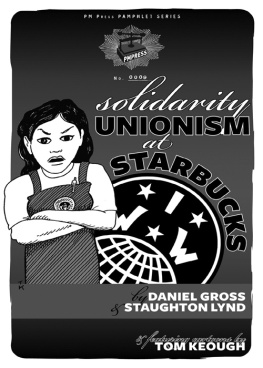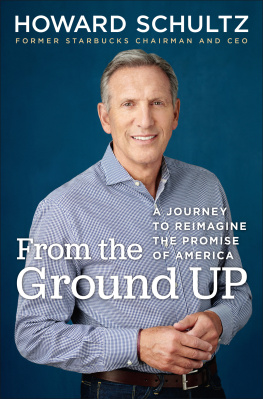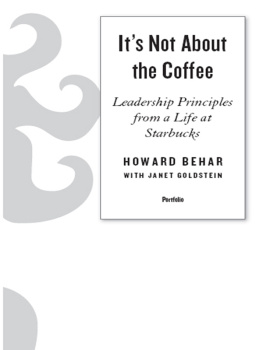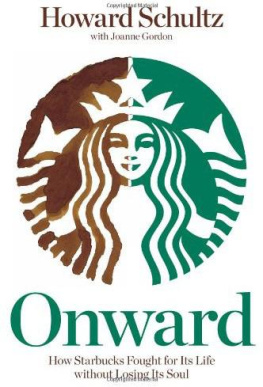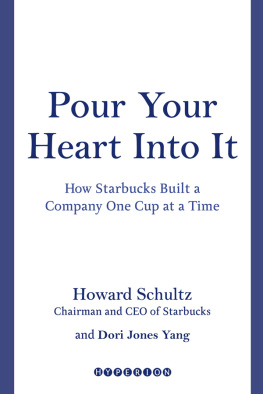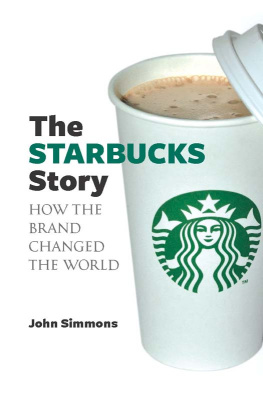Thank you Mom and Dad, for not just being my parents but also being my two best friends.
INTRODUCTION
What Is Tribal Knowledge?
When Howard Schultz took the reins of Starbucks Coffee in 1987a mere six stores, along with his own trio of Il Giornale coffee barshe had the grandiose dream of changing the way Americans drink coffee. Almost 20 years later, Starbucks is by far and away the leader of an industry it createdcozy, welcoming coffeehouses serving specialty coffee and espresso beverages. It is a remarkable story that happened in remarkable ways.
For most Americans who grew up prior to the 1990s, coffee was a necessary, though hardly enjoyable, part of the day. It didnt taste goodthat wasnt the point. Just as we do not expect cough syrup to be delicious, most of us didnt demand much from a cup of coffee except a jump start to our mornings, and maybe a jolt of caffeine to pull us out of our post-lunch comas.
Americans had become accustomed to drinking coffee from cheap, inferior robusta coffee beans, scooped out of three-pound tin cans, flavor nuances scorched beyond recognition from cooking on a heated plate for endless hours, and served with powdered creamer to mask its unbearable taste. Then in 1971, Starbucks was founded in Seattles Pike Place Market by three friends (Jerry Baldwin, Gordon Bowker, and Zev Siegel) who all shared a passion for great-tasting, European-style coffee made from dark-roasted arabica beans. This was coffee that had full flavor without the need of sugar and milk. It was coffee at its purest and tastiest state.
By 1981, Starbucks, with its four locations, caught the attention of a housewares sales representative from New York who wanted to learn why a tiny Seattle coffee company was ordering more coffeemakers than one of the giant national department stores. Howard Schultz was the housewares sales representative, and soon thereafter he parlayed his enchantment for Starbucks into becoming its director of marketing and operations.
In 1983, while on a business trip in Milan, Howard had an epiphany of venti-sized proportions. Enamored with the Italian coffeehouse culture, he envisioned Starbucks selling espresso beverages (caff lattes and cappuccinos) like the tiny cafes in Italy do. He convinced the three Starbucks owners to try out the coffee-bar concept, highlighting handcrafted espresso drinks, in downtown Seattle. Despite the experiments success, however, the owners ultimately differed on what Starbucks business focus should be. Undeterred, Howard left Starbucks to start his own espresso caf, Il Giornale, in 1986.
In less than a year, Il Giornale had opened three locations. But serendipitously, in 1987, Schultz was given the opportunity to buy the company that formerly employed himits six stores and the Starbucks Coffee name. He jumped at the opportunity and began to make reality the company hed envisioned years before.
By 1992 Starbucks had 165 locations, mostly in the Pacific Northwest, Chicago, and Vancouver, Canada, with annual revenues of $103 million. That same year the company went public. Over the next 14 years, its growth would go wild, at first entering new markets in New York, Los Angeles, and Miami, then opening overseas in Japan, and ultimately becoming not just an instantly recognizable national brand, but an international cultural icon. Starbucks now has more than 11,000 locationsgrowing at a rate of 5 new stores a dayin more than 40 countries around the world and with revenues in excess of $6.5 billion. Its stock price has increased over 6,400 percent since its initial public offering.
More important to the Starbucks position of being a leading-edge company, however, is that it actually achieved the daunting goal of changing the way people in Americaand worldwidethink about and enjoy coffee. Starbucks had a mission to change the world. Not simply change their world but change the world. They wanted to improve peoples lives in small but meaningful ways, not just get rich selling stuff. And it is this commitment to serving others that is at the heart of Starbucks success.
As a brand, Starbucks has redefined modern marketing by forsaking the traditional marketing trappings of mass advertising and, instead, focusing on building endearing and enduring relationships with customers one cup, one store, at a time.
For a company that has accomplished so much, its surprising how little the business world really knows about how Starbucks found prosperity from selling a commodity. Thats because much of this companys sage advice and weathered truths exist solely in the hearts and minds of longtime Starbucks partners (employees).
Okay so what is tribal knowledge? Its the name of the book after all.
Starbucks tribal knowledge is an innate language that has never been written, only spoken, and then, only within the Starbucks tribe. Its a pithy quote by a respected Starbucks executive. Its a mantra used by Starbucks project teams to bring forth passionate followership. Its emotionally intense advice from old-school partners that pierces the souls of new-school partners. Its a-ha moments from successful (and failed) projects. Its poignant. Its thought-provoking. Its actionable. Its what built Starbucks the business and Starbucks the brand.
The tribal knowledge shared in this book is based on unwritten, informal organizational wisdom that infused Starbucks success and that continues to be passed down from one generation of managers and baristas to the next, coursing through the veins of the Starbucks company culture much like strong coffee invigoratingly courses through ones veins. This book is a collection of those nuggets of tribal wisdoma written compendium of the truths that, added together, express the learnings and traditions of Starbucks.
There are many roads to success in business. Many businesses focus on price and convenience to attract customersgoods and services are simply a commodity. But in a consumer environment that focuses on delivering these needed commodities quickly, conveniently, and cheaply, with an emphasis on technology and a minimum of personal interaction, theres space for companies that focus on providing an enhanced, more tactile customer experience. Companies that focus on delivering remarkable products and services attract significant attention from customers conditioned to a retail world in which the necessities are bought and sold without fuss or feeling.
Tribal Knowledge is aimed at entrepreneurs and business professionals who embrace that idealthat products and services can do more than just the minimumwho seek to connect in personal, meaningful ways with customers, who over-deliver on the many promises implied in a typical transaction.
The tribal truths discussed in the following pages are business and marketing lessons designed to share ideals and spark ideas you can use to immediately impact your business. Each tribal truth is followed by a number of Leading Questions to prompt you to think about your company and your business practices in different ways. And a short section at the end of the book, From Ideas to Implementation, suggests a number of action steps you can take to improve your business practices now.
But Tribal Knowledge is also more than just a bookits the beginning of a conversation between you, me, and others. I say this because we have the opportunity to share comments, opinions, and rebuttals on everything written in this book by visiting the Tribal Knowledge blog at


